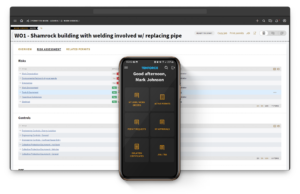Saving Lives Everyday with Permit to Work
Think about all the high-risk jobs that you’ve assessed: complete risk elimination is impossible. That’s why permit-to-work (PtW) exists. These formal, written procedures are designed to prevent workplace accidents and incidents by ensuring that high-risk tasks, such as hot work, confined space entry, and work at height, are carried out safely and efficiently.
They function as a communication tool between site management, supervisors, and those who carry out the work, outlining the exact nature of the work, its location, the methodology, and the precautions necessary to carry it out safely.
But, without the right tools in place, the PtW process can be time-consuming and error-prone.
An Extra Layer of Protection
The importance of PtW cannot be overstated. Without these safety measures, handling workplace risks becomes a logistical nightmare.
Imagine a scenario without PtWs: an employee faces a hazardous task involving a lengthy checklist of intricate steps and procedures. Without formal verification, there’s no guarantee the task will unfold as intended, within the designated timeframe.
Even the most experienced employees can’t ensure their safety without PtWs. Without a formal mechanism to validate compliance with established procedures, there’s no way to guarantee adequate protection from potential risks. In industries requiring PtWs, each misstep carries the weight of potentially catastrophic consequences.
The absence of clear communication among stakeholders about the procedures introduces potential misunderstandings and knowledge gaps. This lack of coordination and shared understanding virtually guarantees workplace incidents.
PtWs ensure safety, clarity, and accountability in high-risk work environments. They serve as the bedrock for incident prevention and risk mitigation, making them indispensable for responsible and secure workplace management.
Lessons from History: Avoiding Disasters Through Clear Communication
In the recent past, we’ve seen catastrophic incidents resulting from the absence of proper Permit-to-work or Lockout/Tagout (LOTO) procedures. These incidents often stem from human error, due to miscommunication, incomplete authorizations, or inadequate risk assessments.
Two examples stand out as vivid reminders of how things can go terribly wrong:
- Piper Alpha Disaster (1988): One of the most notorious industrial disasters in history, the Piper Alpha oil platform explosion in the North Sea resulted in 167 fatalities. The disaster was attributed in part to poor permit-to-work procedures and communication breakdowns.
- Texas City Refinery Explosion (2005): A massive explosion at the BP Texas City refinery led to 15 fatalities and numerous injuries. Investigations revealed shortcomings in safety management systems, including permit-to-work processes.
These tragic incidents underscore a crucial point: Clear and effective communication is of paramount importance to safety in hazardous work environments, and PtW provides that in full.
However, relying on paper-based PtW processes can introduce substantial risks. Paper permits are vulnerable to loss or damage, leading to critical authorization lapses. And, the manual handling of documents can be painfully slow, delaying essential approvals and jeopardizing safety.
Without a consolidated platform, even digitizing these processes can lead to confusion.
The Right Means: Going Digital

By automating complex aspects like communication, verification, conflict tracking, and monitoring, PtW software transforms essential procedures into routine, hassle-free tasks. By implementing TenForce’s PtW module, you can:
- Increase Efficiency: Automate time-consuming administrative tasks, streamline processes and significantly increase productivity.
- Reduce Errors: Minimize the chance of manual errors by standardizing processes, reducing paperwork, and facilitating accurate data entry.
- Enhance Compliance: Gain easy access to permit history and regulatory updates to ensure compliance with internal and external regulations.
- Gain Real-time Visibility: Enable proactive risk management and improved decision-making through real-time visibility into ongoing and upcoming work.
- Standardize: Promoting consistent safety practices across your organization.
- Automate Alerts and Notifications: Received timely alerts for permit expiry dates, ensuring that work is always performed under valid permits.
- Easily Access and Retrieve Information: Easily store and retrieve permits with a digital archive, aiding your audits and incident investigations.
Take the Leap Towards a Lean PtW Process
Are you ready to streamline your PtW processes, but unsure where to begin? Transitioning to a digital solution doesn’t have to be daunting. Start with our on-demand webinar, it’s free to watch and features a comprehensive demo of our PtW module in action.
And, download our free eBook, Your Guide to Using a Lean Approach for Digital Permits to Work, for actionable insights and practical solutions to optimize your Permit to Work processes and drive operational excellence.
You’ll discover the core concepts and challenges associated with permits to work, bridging the gap between safety management and operational excellence. And learn how to say goodbye to:
- Decentralized information
- Confusing task management
- Time-consuming administration
- Conflicting work planning
- Inadequate risk mitigation
- Inconsistent standard operating procedures (SOPs)
Begin your lean digitalization journey!
